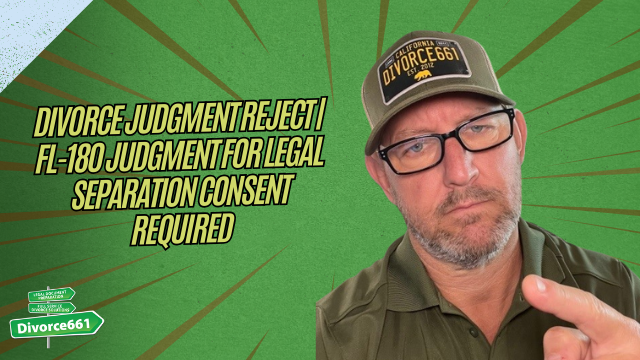Should You Do Your Own California Divorce? Insights from Tim Blankenship Divorce661
Divorce can be one of the most challenging experiences in life, fraught with emotional turmoil, legal complexities, and significant financial considerations. If you live in California and are contemplating ending your marriage, you might be wondering: should I handle the divorce myself, or hire a professional? This is a question that many face, and in this article, I’ll guide you through the essential factors to consider, inspired by the practical advice shared by Tim Blankenship, known for his expertise in California divorce law through his channel Divorce661.
Understanding the Basics of a California Divorce
Before diving into whether you should do your own divorce, it’s important to understand the foundational elements of divorce in California. California is a “no-fault” divorce state, meaning that you don’t have to prove wrongdoing by either spouse to get a divorce. Instead, the only requirement is that there are irreconcilable differences that have led to the breakdown of the marriage.
While this might sound straightforward, the legal process involves several steps:
- Filing the petition for dissolution of marriage
- Serving the other spouse with divorce papers
- Disclosing financial information
- Negotiating child custody and support, if applicable
- Dividing property and debts
- Finalizing the divorce through court orders
Each step requires careful attention to detail, adherence to deadlines, and compliance with California’s family laws.
Why Some People Consider Doing Their Own Divorce
One of the main reasons people consider handling their own divorce is cost. Hiring an attorney can be expensive, and for couples with relatively straightforward situations, it might seem like a reasonable way to save money. Additionally, some individuals feel confident in their ability to navigate legal paperwork or want to maintain control over the process.
However, it’s important to weigh these benefits against the complexity of your unique circumstances. While a DIY divorce might seem like a quick fix, it can lead to mistakes that cause delays, additional costs, or unfavorable agreements.
When Is Doing Your Own Divorce a Viable Option?
Not every divorce case is complicated. If you and your spouse agree on all major issues, such as property division, child custody, and support, a do-it-yourself divorce might be feasible. Here are some conditions where handling your own divorce could work:
- Uncontested Divorce: Both parties agree on all terms and want to finalize the divorce amicably.
- Simple Finances: No complex assets like businesses, multiple properties, or significant debts are involved.
- No Children or Simple Custody Arrangements: Either no children are involved or parents agree on custody and support without disputes.
- Clear Understanding of Legal Procedures: You are comfortable with filling out forms and following court instructions.
Even in these cases, it’s wise to at least consult with a professional to ensure your rights are protected and paperwork is correctly completed.
The Risks of Doing Your Own Divorce
Divorce is not just a legal process; it’s a life-changing event. Mistakes can have long-lasting consequences. Here are some risks of handling your divorce without professional help:
- Incomplete or Incorrect Paperwork: Courts require precise documentation. Errors can cause delays or even dismissal.
- Unfair Settlements: Without legal advice, you might agree to terms that don’t fully protect your interests, especially regarding property division or child custody.
- Overlooking Important Issues: Complex financial matters like retirement accounts, tax implications, or hidden assets can be missed.
- Emotional Stress: Managing negotiations and legal procedures alone can add stress to an already difficult time.
- Enforcement Problems: Improperly drafted agreements might be hard to enforce later.
Tim Blankenship emphasizes the importance of understanding these risks before deciding to go it alone. While the idea of saving money is appealing, it’s crucial to consider the potential costs of mistakes and oversights.
How to Approach a Do-It-Yourself Divorce Responsibly
If after considering the above, you decide to proceed with your own divorce, here are some tips to approach the process responsibly:
1. Educate Yourself Thoroughly
Learn about California divorce laws and procedures. Reliable resources include official court websites, self-help centers, and legal guides. Tim Blankenship’s channel offers valuable insights that can help you understand what to expect.
2. Use Court-Approved Forms
Always use the correct, updated forms provided by California courts. Using outdated or incorrect forms can cause significant delays.
3. Be Honest and Complete in Disclosures
Financial transparency is critical. Both parties must disclose all assets, debts, income, and expenses honestly to avoid future disputes or legal consequences.
4. Communicate Clearly with Your Spouse
Open communication can help you both reach agreements faster and reduce conflict. Consider mediation if you find it difficult to negotiate directly.
5. Seek Limited Legal Advice if Needed
You don’t have to hire an attorney for full representation. Many lawyers offer consultation services or document review at reasonable rates to ensure your paperwork is in order.
When to Hire a Divorce Attorney in California
Some situations make it essential to hire a professional:
- Contested Divorce: If you and your spouse cannot agree on key issues.
- Complex Finances: Ownership of businesses, real estate, investments, or significant debts.
- Child Custody Disputes: When parents disagree on custody or visitation.
- Domestic Violence or Abuse: Protection and safety are paramount.
- Previous Legal Issues: Cases involving prior court orders or complicated family dynamics.
An experienced divorce attorney can navigate these complexities, protect your rights, and help you achieve the best possible outcome.
The Emotional Side of Divorce: Why Support Matters
Divorce is not just a legal process; it’s an emotional journey. Whether you do your own divorce or hire a professional, remember to take care of your mental and emotional health. Seek support from trusted friends, family, or professionals like therapists or support groups.
Tim Blankenship often reminds his viewers that while legal advice is critical, emotional resilience and self-care are equally important during this challenging time.
Conclusion: Making the Right Choice for Your California Divorce
Deciding whether to do your own California divorce is a deeply personal decision that depends on your unique circumstances. While a DIY divorce might seem like a cost-effective and empowering option, it carries risks that can complicate the process and affect your future.
Carefully weigh the complexity of your case, your comfort with legal procedures, and the potential pitfalls before proceeding. If your situation is straightforward and amicable, doing your own divorce with careful preparation and education might be suitable. However, if there are disputes, complex assets, or children involved, professional legal help is often the safer and wiser choice.
For those navigating this difficult path, resources like Tim Blankenship Divorce661 provide valuable guidance and support tailored to California law. Remember, taking the time to understand your options and seek the right help can make all the difference in turning a challenging transition into a new beginning.










